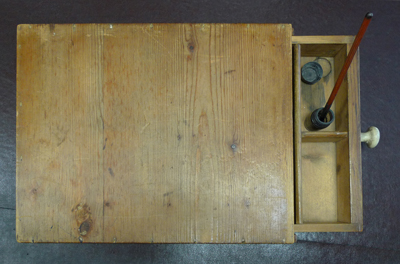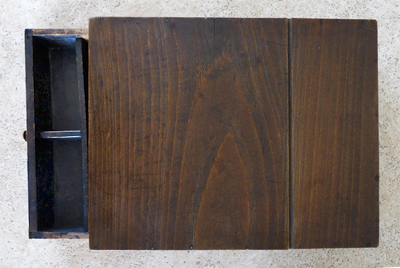
In the 19th century Carmels, there were no desks or tables in the cells. How to write then?... using, in an original way, a small wooden board placed on the knees.
If the small board could also contain writing materials, that would be practical: hence the idea of making a small chest with the writing board on top - a chest that could contain paper, inkwell, pens and a door - pen, scraper and pencil.
The Carmelites did not invent anything, because the inkstand had been present for centuries in France, long before the foundation of Lisieux. It will fall into disuse at the end of the 19th century, with the modernization of writing tools.
Outside the Carmels, these objects were not only utilitarian, they were also decorative! A search with the words "old writing desks" makes it possible to see this, by looking at the images found.
The Carmelite inkstand has the characteristic of being a drawer (containing paper and writing materials) in a box with one side open.

Thérèse, on entering the Carmel in April 1888, found in her cell the writing desk opposite, on the left. Light, in light wood with its white wooden handle, it had no doubt been prepared for Mademoiselle Fleuriot. Therese in fact inherited the white-tinted cell furniture that had been prepared at the end of 1887 for the little neighbor of the Carmel, Jeanne Fleuriot, who ultimately did not enter.
Sitting on her little bench, the Carmelite had to put the object on her knees and take some ink while writing. Not easy according to Céline, who shortly after her entry spilled a whole inkwell on the white wall of the cell and on the floor. The writing desk had slipped!
Read here our old recipe for making ink.
Céline will indeed enter on September 14, 1894. While helping to prepare her beloved sister's cell, Thérèse has the idea of giving her her writing desk, which is so light. She herself goes to get another in the attic, where the obsolete objects are stored. She finds this one (photo on the right) heavier and very damaged.

Note on the photos below the degradation of this writing desk, an old object probably dating back to the foundation (1838):
- the wood is split on the top of the box, which is very boring to write on.
- the back of the drawer is bent
- as well as the small boxes to place the inkwell and the feathers.


As amusingly illustrated Sr Marie du Saint-Esprit on wash drawings, Thérèse wrote her major works on this writing desk.
They include the three manuscripts, 7 of his 8 piecees of theater, 53 of his 62 poems,
16 prayers of the 21 she composed and 95 of her 266 letters, including those to his brother priests.

http://dumas.ccsd.cnrs.fr/docs/00/32/63/13/PDF/Les_ecritoires_neoclassiques_francaises_1.pdf


